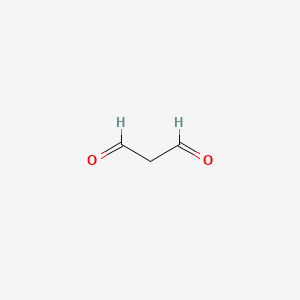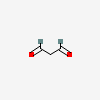Malondialdehyde
- OCHCH2CHO
- C3H4O2
- Propanedial
- Malondialdehyde
- MALONALDEHYDE
- 542-78-9
- Malonyldialdehyde
- Create:2005-08-08
- Modify:2025-01-18

- Malonaldehyde
- Malondialdehyde
- Malondialdehyde, Sodium
- Malonylaldehyde
- Malonyldialdehyde
- Propanedial
- Sodium Malondialdehyde
- Propanedial
- Malondialdehyde
- MALONALDEHYDE
- 542-78-9
- Malonyldialdehyde
- Malonodialdehyde
- Malonic aldehyde
- 1,3-Propanedial
- Malonic dialdehyde
- 1,3-Propanedione
- 1,3-Propanedialdehyde
- CCRIS 5168
- HSDB 4353
- NCI-C54842
- UNII-4Y8F71G49Q
- BRN 1209262
- CHEBI:566274
- MALONALDEHYDE [HSDB]
- MALONALDEHYDE [IARC]
- MALONDIALDEHYDE [MI]
- DTXSID90202556
- 4Y8F71G49Q
- 4-01-00-03634 (Beilstein Handbook Reference)
- MDD
- MALONALDEHYDE (IARC)
- malonicdialdehyde
- 1,3propanedione
- 1,3Propanedial
- 1,3Propanedialdehyde
- beta-ketopropionaldehyde
- Epitope ID:140943
- CHEMBL446036
- DTXCID20125047
- WSMYVTOQOOLQHP-UHFFFAOYSA-N
- DB03057
- NS00069961
- C19440
- EN300-7316484
- Q418661
- Coriolis coupling
- Schoenflies notation
- Centrifugal distortion
- Chemical bond
- Electric dipole moment
- Equilibrium structure
- Internuclear distance
- Molecular structure
- Nuclear quadrupole coupling
- Point group
- Quadrupole coupling
- Rotation-vibration spectrum
- Rotational excitation cross section
- Vibrational mode frequency
(See general first aid procedures)
Eye: Irrigate immediately - If this chemical contacts the eyes, immediately wash (irrigate) the eyes with large amounts of water, occasionally lifting the lower and upper lids. Get medical attention immediately.
Skin: Water flush immediately - If this chemical contacts the skin, immediately flush the contaminated skin with water. If this chemical penetrates the clothing, immediately remove the clothing and flush the skin with water. Get medical attention promptly.
Breathing: Respiratory support
Swallow: Medical attention immediately - If this chemical has been swallowed, get medical attention immediately.
Ca [N.D.]
See: IDLH INDEX
(See personal protection and sanitation codes)
Skin: Prevent skin contact - Wear appropriate personal protective clothing to prevent skin contact.
Eyes: Prevent eye contact - Wear appropriate eye protection to prevent eye contact.
Wash skin: When contaminated/Daily
Remove: When wet or contaminated
Change: Daily - Workers whose clothing may have become contaminated should change into uncontaminated clothing before leaving the work premises.
Provide: Eyewash, Quick drench
NIOSH
At concentrations above the NIOSH REL, or where there is no REL, at any detectable concentration:
(APF = 10,000) Any self-contained breathing apparatus that has a full facepiece and is operated in a pressure-demand or other positive-pressure mode
(APF = 10,000) Any supplied-air respirator that has a full facepiece and is operated in a pressure-demand or other positive-pressure mode in combination with an auxiliary self-contained positive-pressure breathing apparatus
Escape:
(APF = 50) Any air-purifying, full-facepiece respirator (gas mask) with a chin-style, front- or back-mounted organic vapor canister
Any appropriate escape-type, self-contained breathing apparatus
Volume 36: (1985) Allyl Compounds, Aldehydes, Epoxides and Peroxides
Volume Sup 7: Overall Evaluations of Carcinogenicity: An Updating of IARC Monographs Volumes 1 to 42, 1987; 440 pages; ISBN 92-832-1411-0 (out of print)
Volume 71: (1999) Re-evaluation of Some Organic Chemicals, Hydrazine and Hydrogen Peroxide (Part 1, Part 2, Part 3)
Neurotoxin - Other CNS neurotoxin
Occupational hepatotoxin - Secondary hepatotoxins: the potential for toxic effect in the occupational setting is based on cases of poisoning by human ingestion or animal experimentation.
Geigy Scientific Tables, 8th Rev edition, pp. 165-177. Edited by C. Lentner, West Cadwell, N.J.: Medical education Div., Ciba-Geigy Corp., Basel, Switzerland c1981-1992.
Merck Manual of Diagnosis and Therapy.
Geigy Scientific Tables, 8th Rev edition, pp. 165-177. Edited by C. Lentner, West Cadwell, N.J.: Medical education Div., Ciba-Geigy Corp., Basel, Switzerland c1981-1992.
Geigy Scientific Tables, 8th Rev edition, pp. 80-82. Edited by C. Lentner, West Cadwell, N.J.: Medical education Div., Ciba-Geigy Corp., Basel, Switzerland c1981-1992.
Geigy Scientific Tables, 8th Rev edition, pp. 130. Edited by C. Lentner, West Cadwell, N.J.: Medical education Div., Ciba-Geigy Corp. Basel, Switzerland c1981-1992.
David F. Putnam Composition and Concentrative Properties of Human Urine. NASA Contractor Report. July 1971
National Health and Nutrition Examination Survey (NHANES Survey) 2013
Patents are available for this chemical structure:
https://patentscope.wipo.int/search/en/result.jsf?inchikey=WSMYVTOQOOLQHP-UHFFFAOYSA-N
- CAS Common ChemistryLICENSEThe data from CAS Common Chemistry is provided under a CC-BY-NC 4.0 license, unless otherwise stated.https://creativecommons.org/licenses/by-nc/4.0/
- ChemIDplusChemIDplus Chemical Information Classificationhttps://pubchem.ncbi.nlm.nih.gov/source/ChemIDplus
- DrugBankLICENSECreative Common's Attribution-NonCommercial 4.0 International License (http://creativecommons.org/licenses/by-nc/4.0/legalcode)https://www.drugbank.ca/legal/terms_of_useMalonaldehydehttps://www.drugbank.ca/drugs/DB03057
- EPA DSSToxMalonaldehydehttps://comptox.epa.gov/dashboard/DTXSID90202556CompTox Chemicals Dashboard Chemical Listshttps://comptox.epa.gov/dashboard/chemical-lists/
- FDA Global Substance Registration System (GSRS)LICENSEUnless otherwise noted, the contents of the FDA website (www.fda.gov), both text and graphics, are not copyrighted. They are in the public domain and may be republished, reprinted and otherwise used freely by anyone without the need to obtain permission from FDA. Credit to the U.S. Food and Drug Administration as the source is appreciated but not required.https://www.fda.gov/about-fda/about-website/website-policies#linking
- Hazardous Substances Data Bank (HSDB)MALONALDEHYDEhttps://pubchem.ncbi.nlm.nih.gov/source/hsdb/4353
- Human Metabolome Database (HMDB)LICENSEHMDB is offered to the public as a freely available resource. Use and re-distribution of the data, in whole or in part, for commercial purposes requires explicit permission of the authors and explicit acknowledgment of the source material (HMDB) and the original publication (see the HMDB citing page). We ask that users who download significant portions of the database cite the HMDB paper in any resulting publications.http://www.hmdb.ca/citingMalondialdehydehttp://www.hmdb.ca/metabolites/HMDB0006112
- ILO-WHO International Chemical Safety Cards (ICSCs)
- The National Institute for Occupational Safety and Health (NIOSH)LICENSEThe information provided using CDC Web site is only intended to be general summary information to the public. It is not intended to take the place of either the written law or regulations.https://www.cdc.gov/Other/disclaimer.htmlMalonaldehydehttps://www.cdc.gov/niosh/npg/npgd0377.html
- ChEBI
- LOTUS - the natural products occurrence databaseLICENSEThe code for LOTUS is released under the GNU General Public License v3.0.https://lotus.nprod.net/Malonaldehydehttps://www.wikidata.org/wiki/Q418661LOTUS Treehttps://lotus.naturalproducts.net/
- NCI Thesaurus (NCIt)LICENSEUnless otherwise indicated, all text within NCI products is free of copyright and may be reused without our permission. Credit the National Cancer Institute as the source.https://www.cancer.gov/policies/copyright-reuseNCI Thesaurushttps://ncit.nci.nih.gov
- Toxin and Toxin Target Database (T3DB)LICENSET3DB is offered to the public as a freely available resource. Use and re-distribution of the data, in whole or in part, for commercial purposes requires explicit permission of the authors and explicit acknowledgment of the source material (T3DB) and the original publication.http://www.t3db.ca/downloadsMalondialdehydehttp://www.t3db.ca/toxins/T3D4182
- ChEMBLLICENSEAccess to the web interface of ChEMBL is made under the EBI's Terms of Use (http://www.ebi.ac.uk/Information/termsofuse.html). The ChEMBL data is made available on a Creative Commons Attribution-Share Alike 3.0 Unported License (http://creativecommons.org/licenses/by-sa/3.0/).http://www.ebi.ac.uk/Information/termsofuse.htmlChEMBL Protein Target Treehttps://www.ebi.ac.uk/chembl/g/#browse/targets
- Comparative Toxicogenomics Database (CTD)LICENSEIt is to be used only for research and educational purposes. Any reproduction or use for commercial purpose is prohibited without the prior express written permission of NC State University.http://ctdbase.org/about/legal.jspMalondialdehydehttps://ctdbase.org/detail.go?type=chem&acc=D008315
- DailyMed
- FooDBLICENSEFooDB is offered to the public as a freely available resource. Use and re-distribution of the data, in whole or in part, for commercial purposes requires explicit permission of the authors and explicit acknowledgment of the source material (FooDB) and the original publication.https://foodb.ca/about1,3-Propanedialhttps://foodb.ca/compounds/FDB008116
- Haz-Map, Information on Hazardous Chemicals and Occupational DiseasesLICENSECopyright (c) 2022 Haz-Map(R). All rights reserved. Unless otherwise indicated, all materials from Haz-Map are copyrighted by Haz-Map(R). No part of these materials, either text or image may be used for any purpose other than for personal use. Therefore, reproduction, modification, storage in a retrieval system or retransmission, in any form or by any means, electronic, mechanical or otherwise, for reasons other than personal use, is strictly prohibited without prior written permission.https://haz-map.com/AboutMalonaldehydehttps://haz-map.com/Agents/99
- International Agency for Research on Cancer (IARC)LICENSEMaterials made available by IARC/WHO enjoy copyright protection under the Berne Convention for the Protection of Literature and Artistic Works, under other international conventions, and under national laws on copyright and neighbouring rights. IARC exercises copyright over its Materials to make sure that they are used in accordance with the Agency's principles. All rights are reserved.https://publications.iarc.fr/Terms-Of-UseIARC Classificationhttps://www.iarc.fr/
- Japan Chemical Substance Dictionary (Nikkaji)
- KEGGLICENSEAcademic users may freely use the KEGG website. Non-academic use of KEGG generally requires a commercial licensehttps://www.kegg.jp/kegg/legal.html
- KNApSAcK Species-Metabolite Database
- Natural Product Activity and Species Source (NPASS)
- MarkerDBLICENSEThis work is licensed under a Creative Commons Attribution-NonCommercial 4.0 International License.https://markerdb.ca/Malondialdehydehttps://markerdb.ca/chemicals/1297
- Metabolomics Workbench
- National Drug Code (NDC) DirectoryLICENSEUnless otherwise noted, the contents of the FDA website (www.fda.gov), both text and graphics, are not copyrighted. They are in the public domain and may be republished, reprinted and otherwise used freely by anyone without the need to obtain permission from FDA. Credit to the U.S. Food and Drug Administration as the source is appreciated but not required.https://www.fda.gov/about-fda/about-website/website-policies#linking
- NLM RxNorm TerminologyLICENSEThe RxNorm Terminology is created by the National Library of Medicine (NLM) and is in the public domain and may be republished, reprinted and otherwise used freely by anyone without the need to obtain permission from NLM. Credit to the U.S. National Library of Medicine as the source is appreciated but not required. The full RxNorm dataset requires a free license.https://www.nlm.nih.gov/research/umls/rxnorm/docs/termsofservice.htmlmalondialdehydehttps://rxnav.nlm.nih.gov/id/rxnorm/1657018
- NORMAN Suspect List ExchangeLICENSEData: CC-BY 4.0; Code (hosted by ECI, LCSB): Artistic-2.0https://creativecommons.org/licenses/by/4.0/MalonaldehydeNORMAN Suspect List Exchange Classificationhttps://www.norman-network.com/nds/SLE/
- Protein Data Bank in Europe (PDBe)
- RCSB Protein Data Bank (RCSB PDB)LICENSEData files contained in the PDB archive (ftp://ftp.wwpdb.org) are free of all copyright restrictions and made fully and freely available for both non-commercial and commercial use. Users of the data should attribute the original authors of that structural data.https://www.rcsb.org/pages/policies
- Rhea - Annotated Reactions DatabaseLICENSERhea has chosen to apply the Creative Commons Attribution License (http://creativecommons.org/licenses/by/4.0/). This means that you are free to copy, distribute, display and make commercial use of the database in all legislations, provided you credit (cite) Rhea.https://www.rhea-db.org/help/license-disclaimer
- SpectraBaseMalondialdehydehttps://spectrabase.com/spectrum/G5kfjao1fzzMalonaldehydehttps://spectrabase.com/spectrum/Exfv9S2DXqy
- Springer Nature
- SpringerMaterials
- Thieme ChemistryLICENSEThe Thieme Chemistry contribution within PubChem is provided under a CC-BY-NC-ND 4.0 license, unless otherwise stated.https://creativecommons.org/licenses/by-nc-nd/4.0/
- Wikidatamalondialdehydehttps://www.wikidata.org/wiki/Q418661
- WikipediaMalondialdehydehttps://en.wikipedia.org/wiki/Malondialdehyde
- Wiley
- Medical Subject Headings (MeSH)LICENSEWorks produced by the U.S. government are not subject to copyright protection in the United States. Any such works found on National Library of Medicine (NLM) Web sites may be freely used or reproduced without permission in the U.S.https://www.nlm.nih.gov/copyright.htmlMalondialdehydehttps://www.ncbi.nlm.nih.gov/mesh/68008315
- PubChem
- EPA Substance Registry ServicesEPA SRS List Classificationhttps://sor.epa.gov/sor_internet/registry/substreg/LandingPage.do
- MolGenieMolGenie Organic Chemistry Ontologyhttps://github.com/MolGenie/ontology/
- PATENTSCOPE (WIPO)SID 403420327https://pubchem.ncbi.nlm.nih.gov/substance/403420327
- NCBI

